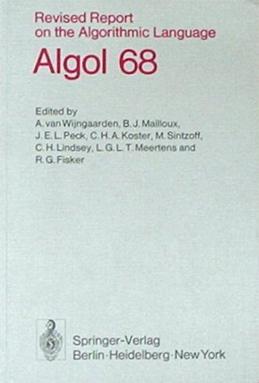Structured programming is a programming paradigm aimed at improving the clarity, quality, and development time of a computer program by making extensive use of the structured control flow constructs of selection (if/then/else) and repetition, block structures, and subroutines.
Hoare logic is a formal system with a set of logical rules for reasoning rigorously about the correctness of computer programs. It was proposed in 1969 by the British computer scientist and logician Tony Hoare, and subsequently refined by Hoare and other researchers. The original ideas were seeded by the work of Robert W. Floyd, who had published a similar system for flowcharts.
In computer programming, specifically when using the imperative programming paradigm, an assertion is a predicate connected to a point in the program, that always should evaluate to true at that point in code execution. Assertions can help a programmer read the code, help a compiler compile it, or help the program detect its own defects.
Curry is an experimental functional logic programming language, based on the Haskell language. It merges elements of functional and logic programming, including constraint programming integration.
In computer programming, a block or code block or block of code is a lexical structure of source code which is grouped together. Blocks consist of one or more declarations and statements. A programming language that permits the creation of blocks, including blocks nested within other blocks, is called a block-structured programming language. Blocks are fundamental to structured programming, where control structures are formed from blocks.

In computer science, conditionals are programming language commands for handling decisions. Specifically, conditionals perform different computations or actions depending on whether a programmer-defined Boolean condition evaluates to true or false. In terms of control flow, the decision is always achieved by selectively altering the control flow based on some condition . Although dynamic dispatch is not usually classified as a conditional construct, it is another way to select between alternatives at runtime. Conditional statements are the checkpoints in the programe that determines behaviour according to situation.

In computer science a for-loop or for loop is a control flow statement for specifying iteration. Specifically, a for loop functions by running a section of code repeatedly until a certain condition has been satisfied.
In computer programming, the ternary conditional operator is a ternary operator that is part of the syntax for basic conditional expressions in several programming languages. It is commonly referred to as the conditional operator, ternary if, or inline if. An expression a ? b : c evaluates to b if the value of a is true, and otherwise to c. One can read it aloud as "if a then b otherwise c". The form a ? b : c is by far and large the most common, but alternative syntaxes do exist; for example, Raku uses the syntax a ?? b !! c to avoid confusion with the infix operators ? and !, whereas in Visual Basic .NET, it instead takes the form If(a, b, c).

ALGOL 68 is an imperative programming language that was conceived as a successor to the ALGOL 60 programming language, designed with the goal of a much wider scope of application and more rigorously defined syntax and semantics.
Short-circuit evaluation, minimal evaluation, or McCarthy evaluation is the semantics of some Boolean operators in some programming languages in which the second argument is executed or evaluated only if the first argument does not suffice to determine the value of the expression: when the first argument of the AND function evaluates to false, the overall value must be false; and when the first argument of the OR function evaluates to true, the overall value must be true.
Predicate transformer semantics were introduced by Edsger Dijkstra in his seminal paper "Guarded commands, nondeterminacy and formal derivation of programs". They define the semantics of an imperative programming paradigm by assigning to each statement in this language a corresponding predicate transformer: a total function between two predicates on the state space of the statement. In this sense, predicate transformer semantics are a kind of denotational semantics. Actually, in guarded commands, Dijkstra uses only one kind of predicate transformer: the well-known weakest preconditions.
In computer science, the Actor model and process calculi are two closely related approaches to the modelling of concurrent digital computation. See Actor model and process calculi history.
In digital logic design, an asynchronous circuit is quasi delay-insensitive (QDI) when it operates correctly, independent of gate and wire delay with the weakest exception necessary to be turing-complete.
PROMELA is a verification modeling language introduced by Gerard J. Holzmann. The language allows for the dynamic creation of concurrent processes to model, for example, distributed systems. In PROMELA models, communication via message channels can be defined to be synchronous, or asynchronous. PROMELA models can be analyzed with the SPIN model checker, to verify that the modeled system produces the desired behavior. An implementation verified with Isabelle/HOL is also available, as part of the Computer Aided Verification of Automata (CAVA) project. Files written in Promela traditionally have a .pml file extension.
PLEXIL is an open source technology for automation, created and currently in development by NASA.
Joyce is a secure programming language for concurrent computing designed by Per Brinch Hansen in the 1980s. It is based on the sequential language Pascal and the principles of communicating sequential processes (CSP). It was created to address the shortcomings of CSP to be applied as a programming language, and to provide a tool, mainly for teaching, for distributed computing system implementation.
Predicative programming is the original name of a formal method for program specification and refinement, more recently called a Practical Theory of Programming, invented by Eric Hehner. The central idea is that each specification is a binary (boolean) expression that is true of acceptable computer behaviors and false of unacceptable behaviors. It follows that refinement is just implication. This is the simplest formal method, and the most general, applying to sequential, parallel, stand-alone, communicating, terminating, nonterminating, natural-time, real-time, deterministic, and probabilistic programs, and includes time and space bounds.
Tracing just-in-time compilation is a technique used by virtual machines to optimize the execution of a program at runtime. This is done by recording a linear sequence of frequently executed operations, compiling them to native machine code and executing them. This is opposed to traditional just-in-time (JIT) compilers that work on a per-method basis.
Janus is a time-reversible programming language written at Caltech in 1982. The operational semantics of the language were formally specified, together with a program inverter and an invertible self-interpreter, in 2007 by Tetsuo Yokoyama and Robert Glück. A Janus inverter and interpreter is made freely available by the TOPPS research group at DIKU. Another Janus interpreter was implemented in Prolog in 2009. The below summarises the language presented in the 2007 paper.
In computer science, interference freedom is a technique for proving partial correctness of concurrent programs with shared variables. Hoare logic had been introduced earlier to prove correctness of sequential programs. In her PhD thesis under advisor David Gries, Susan Owicki extended this work to apply to concurrent programs.




